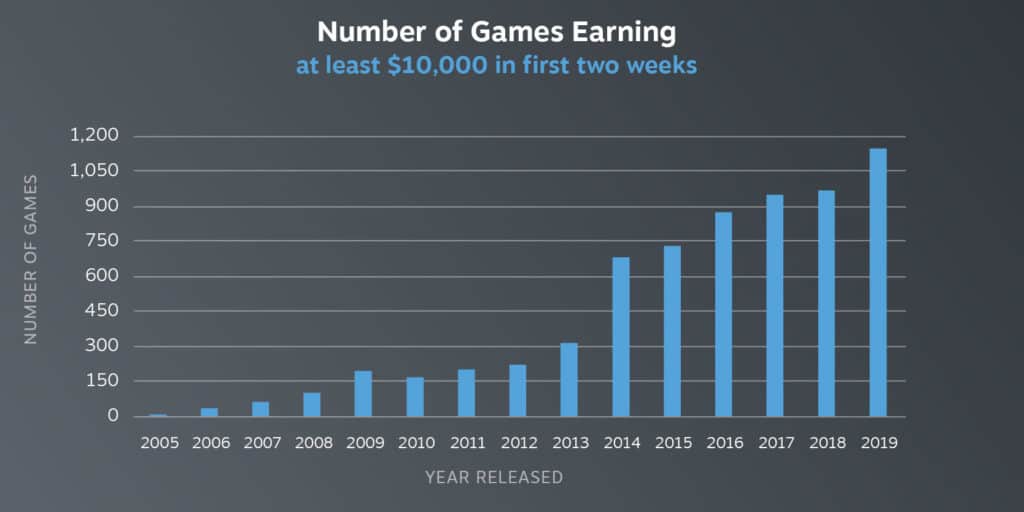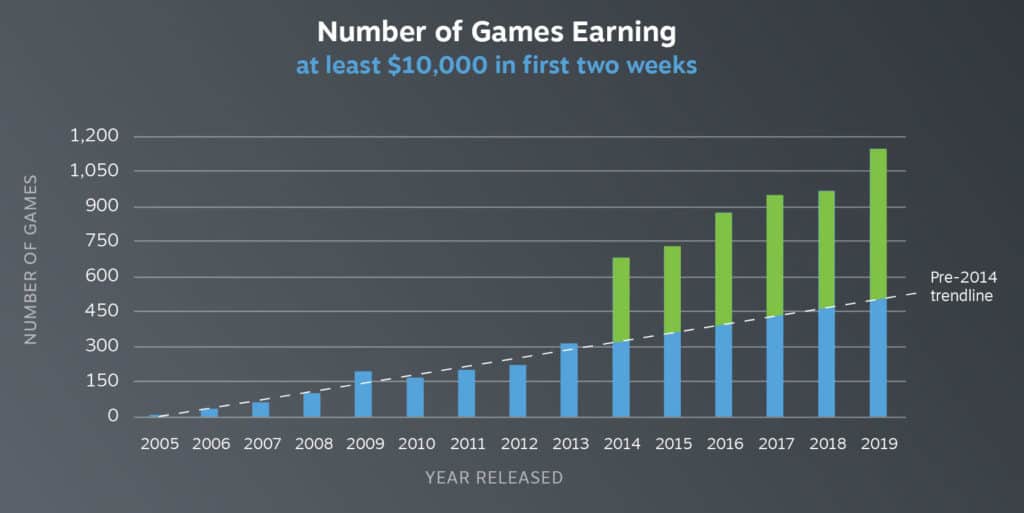Valve share a deep dive into sales data for Steam
Valve lift the curtain on how sales on Steam have changed as they’ve opened up their submission process
- Last Updated Apr 8, 2020

Valve launched its industry-leading digital distribution Steam all the way back in 2003, and at the time it was just used for distributing Valve’s own titles, like CounterStrike, Day of Defeat and of course Half-Life. Then in 2005, they opened up to third-party sellers, with early titles on the service like Rag Doll Kung Fu and Darwinia. Since then, the number of titles released on Steam has ballooned, with each year seeing an increasing number of releases, and now we see an average of around 22 games added to the service each day.
The Steam submission process has had to evolve in order to manage the increasing numbers of releases. It started off with a black box, opaque process, where developers had to just generate enough attention to attract Valve’s interest, and cross their fingers that Valve would reach out. Eventually, this proved to be a significant bottleneck, so preventing or delaying releases of games that might have otherwise been able to attract an audience on Steam. To remove this bottleneck, and avoid games from flying under their radar, in 2012 Valve pushed for a new initiative dubbed Greenlight, a process where developers wishing to release their game on Steam could create a publicly listed page on the Greenlight section of the Steam webpage, and users could register their interest in games. Valve would then review submitted games, prioritising those that had generated the most interest. As Valve iterated on the Greenlight process, seeking to speed up the time and reduce the complexity of the process of getting games ready to release, in 2017 they evolved Greenlight into Steam Direct, with essentially removed the public voting phase, letting developers bypass the song and dance of campaigning for votes and just release their game with few barriers.
This gradual shift of opening up access to their storefront has been great for indie developers who want to access the huge player base on Steam and has resulted in developers who previously would have been ignored or outright rejected from Steam having a chance to sell there, a democratising effect on distribution to help all developers compete on something that is closer to a level playing field. That’s not to say it’s been well-received by all corners of the industry, where some developers who were well placed to navigate the older systems are finding themselves in a position where they have to compete with far more games to attract players’ attention. In the past, when far fewer games were allowed to release on Steam, being one of the lucky few was almost like a golden ticket to success, but that came at the expense of denying far more developers even a chance. Now things are far more egalitarian, where being well connected in the industry does not impact your access to distribution on Steam in the same manner.
But it’s not been entirely clear to what extent this shift had increased the number of success stories on Steam. Some alarmists have liked to argue that flooding Steam with perceived low-quality games had brought the number of successful games down, as it became harder for players to sift through the chaff in search of wheat. Valve has done a lot of work in pushing for newer forms of discovery on their storefront, seeking to present players with customised recommendations to suit their interests, and in my view still have a lot of work to do in this regard, but it’s an open question to what extent this approach has worked. Or at least it was until Valve published some sales data relevant to this question.

In a new blog post titled “Data Deep Dive: How are new releases on Steam performing?”, Valve has shared a host of new data on sales of games on their platform over time, focussing on how their shifts in submission processes have impacted the number of successful titles.
It’s a fascinating read, with some interesting data being presented.
This chart shows the number of titles that have broken the $10,000 sales threshold in the first two weeks of availability. It’s not clear exactly how they reached this number, and that’s going to include titles that go on to generate millions of dollars in revenue and titles that fizzle out after that early peak. Many titles will have quite a long tail in terms of revenue generated on Steam, where even years after release they continue to bring in some revenue, often with spikes associated with discounts or updates, etc. Valve at least consider this to be a threshold by which we can consider a baseline for success, and as we can see both in 2012 and 2017, the years where Valve altered their policies to grant more developers access to their store, we saw these numbers either remain stable or increase.
This to some extent confirms the theory that there were potentially popular games that were being ignored by Valve before, and these games that were in Valve’s blind spot were able to find an audience once granted the opportunity to do so, resulting in a net increase in successful titles on Steam.

Or as Valve has put it:
“We opened the platform because we believed that “hand curating” the titles released on Steam had led to some great titles being missed. To test this, let’s suppose we had never opened the platform. The dashed line in the graph below estimates what the trend would have looked like if we hadn’t increased the quantity of games accepted to the platform in mid-2013. Assuming the trend was stable, it suggests that opening the platform more than doubled the number of releases meeting the $10K benchmark each year. While we can’t say for sure, we think the green portions of the bars above the dashed line are, largely, games that would never have previously found success on Steam… because they never would have been released on the platform at all.”
It’s worth checking out the entire report if you want to know more.
Broadly speaking, I think the data supports the idea that Valve achieved what they set out to when they sought to democratise distribution on Steam, and so they are indeed seeing more success stories. It’s also helped Steam become less American and European-centric, where there are more success stories on the platform for games from Japan, China, Russia and other parts of the world that were under-represented under the old systems.
That’s not to say that Valve is getting everything right. They are doing interesting things with machine learning to fine-tune their storefront with the Steam Labs initiative, which I think will improve things in the future, but I still feel like this is not an adequate replacement for human curation.
In the past, their curation process was to reject games from releasing, which I think is a dated concept and it is for the best that they no longer do this. I do think that they should still have an editorial voice though. It’s a digital storefront, so shelf space is not a limited resource, and no users complain about there being too many songs on Spotify, too many videos on youtube, or too many products for sale on Amazon. Similarly “too many games on Steam” is not a problem, but “I find it difficult to find new interesting games on Steam” is a problem for some users. I would love to see some more effort for Valve to unearth and highlight interesting new releases with some degree of subjective assessment. Right now, Valve simply relies on algorithms and user metrics to highlight individual games, but it feels to me that with access to the literally mountain of cash reserves they have, it should be entirely possible to put together a small team to work on drawing attention to noteworthy games that might otherwise fall through the cracks. Perhaps in the format of a regular video series, perhaps in a section of the store for “Staff picks”, perhaps a badge that could be applied to certain games for “We played this and we like it”, or perhaps some combination of all of those. I’d love to see Valve having more of a customer-facing voice. The old system where games that failed to make it through Valve’s curation process were entirely rejected was not the right system, but I don’t think that this means there is no value in Valve performing some kind of subjective curation themselves.
How do you feel about Valve’s storefront policies these days? Are there any games you love on Steam that might not have made it on there under the old policies? What kinds of changes might you like to see going forward? Let us know what you think in the comments.
